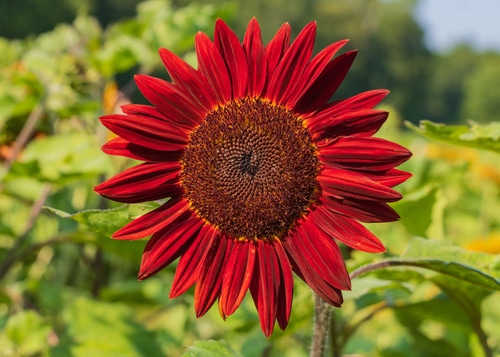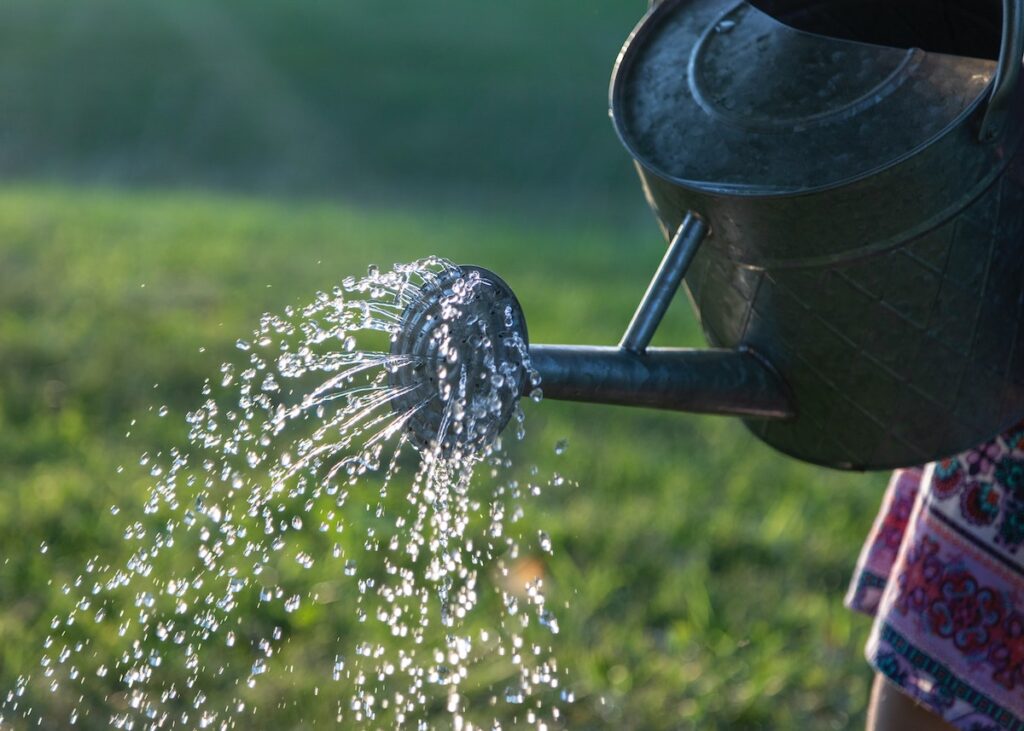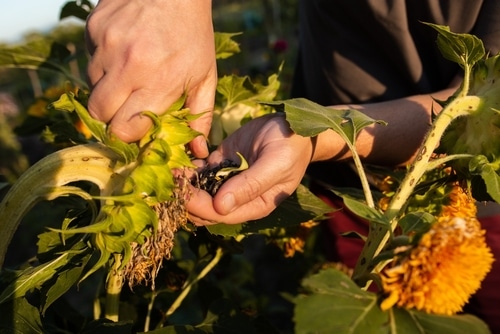Log in or create new account to save this product to your wishlist.

How to Plant, Grow and Care for Sunflowers
Transform your yard with sunflowers – learn how to plant, grow, and care for these tall, large, and cheerful summertime show-stoppers.
🌱 All important maintenance moments for your lawn during the year. Leave your email and we will send you the lawn calendar for free.
Enter your email
Receive the lawn calendar in the mail
Enjoy a green lawn all year round!

- Order by 2PM = shipped today
- 250.000+ satisfied customers!
- 60 day satisfaction guarantee
Do you gaze longingly at other people’s front gardens, admiring those tall, majestic sunflower blooms? Well, luckily, sunflowers are one of the easiest plants to grow and look after, offering plenty of bang for your buck.
- Understanding sunflowers
- Choosing the right sunflower variety
- Preparing for planting sunflower seeds
- When to plant sunflower seeds
- How to plant sunflower seeds
- Sunflower care: ensuring healthy growth
- Harvesting sunflowers: reaping the rewards
- Common sunflower pests and diseases
- FAQs
- A Sunflower-Filled Garden
Indeed, sunflowers are a delightful and easy-grow plant that enhances the appeal of your garden while attracting wildlife.
This comprehensive guide provides all the information you need to cultivate, nurture, and preserve your sunflower plants successfully.
Ready? Let’s get started!
Understanding sunflowers

Sunflowers, scientifically known as Helianthus annuus, are annual plants widely recognised for their large, radiant, daisy-like flower heads. They originate from the Greek words helios (sun) and anthos (flower) owing to their sun-following nature. This is because sunflowers exhibit heliotropism, a phenomenon where the plant’s flowers track the sun’s movement from east to west, returning at night to face the east, ready for the morning sun.
We’re all familiar with the classic, sunny yellow bloom, but the flowers actually come in a multitude of colours, including yellow, red, orange, maroon, and brown.
However, the classic golden-yellow with brown centres is the most common. These brown centres mature into heavy heads filled with seeds, making them a favourite among birds and gardeners alike.
Choosing the right sunflower variety

With over seventy varieties, sunflowers come in various sizes, from miniature bloomers that are barely 50cm (20in) tall to giant varieties towering over 3m (10ft).
So, depending on your garden’s size and your aesthetic preference, you can choose from an extensive range of sunflower varieties.
Additionally, sunflowers make excellent companion plants for your vegetable patch, attracting slugs, snails, and other hungry flying pests away from your crops. The high sugar content of the stalk is particularly attractive, and the pests won’t do as much damage to your sunflowers as they would to your courgettes!
Giant sunflowers
If you’re aiming for a towering spectacle, giant sunflowers like the ‘Russian Giant’ are an excellent choice. These can grow as tall as 3m (10ft) and sport bright golden-yellow flowers.
Tall sunflowers
Varieties like ‘Velvet Queen,’ ‘Earth Walker,’ ‘Red Sun,’ and ‘Valentine’ grow up to 1.8m (6ft) tall and offer a variety of colours, including deep red, bronze, orange, and yellow.
Dwarf sunflowers

If your space is limited, dwarf sunflowers like ‘Teddy Bear’ and ‘Dwarf Yellow Spray’ are a perfect choice. These bushy plants grow up to 60cm (2ft) tall and are ideal for containers or small gardens.
Preparing for planting sunflower seeds
Sunflowers are among the easiest of all flowers to cultivate from seed, but before you start sowing, there are a few things to gather:
- Sunflower seeds: Choose the varieties that best suit your garden and the available space. You can purchase seeds online or from your local garden centre.
- Rake and trowel: These will be useful for preparing the soil and planting the seeds.
- Pots and compost: If you’re starting your seeds indoors, you’ll need small pots and high-quality compost like Miracle-Gro Premium All Purpose compost.
- Clear plastic bags or a propagator: These will help create a warm and humid environment for germinating seeds.
When to plant sunflower seeds
Sow your sunflower seeds after the potential for frost has passed. Wait until the soil has warmed – it needs to be at least 10°C. In the UK, this is typically between mid-April to May.
How to plant sunflower seeds

It’s possible to sow sunflower seeds directly into your outdoor soil or indoors in pots. Both methods have their advantages:
Sowing sunflower seeds outdoors
Outdoor sowing means that your plant grows in its final position. There’s no need to disturb the plant by transplanting it once it has germinated.
Follow these steps to sow sunflower seeds directly in your garden:
- Prepare the soil: Sunflowers prefer a well-draining, nutrient-rich soil. Clear away any existing weeds and dig in plenty of compost or well-rotted farmyard manure.
- Create drills: Make shallow depressions in the soil for each seed. Leave a 10cm gap between each seed. The drills should be about 12mm deep. Avoid the temptation to crowd the plants — they need space to thrive.
- Plant the seeds: Carefully place the seeds into the drill and cover with soil. Water the seeds well.
- Protect the seeds: If birds are hovering around, spread netting over the planted area until they germinate.
Germinating sunflower seeds indoors
Germinating your sunflower seeds indoors ensures you’re in better control of the climate around your seed drills. It’s also easier to identify when to water the seedlings.
If you want a head start or have a shorter growing season, germinating sunflower seeds indoors can be advantageous:
- Fill pots with compost: Fill biodegradable pots with an organic growing medium.
- Sow the seeds: Plant one sunflower seed per pot, approximately 4cm deep.
- Place pots in a warm area: Put the growing pots on a warm windowsill or germinate them in a greenhouse.
- Keep the soil moist: Water the soil daily until seeds germinate, which usually takes approximately seven days. Never allow the soil to become waterlogged (but never allow it to dry out).
- Harden off the seedings: Once the sunflowers are a few inches tall and growing their first set of true leaves, it’s time to harden them off — take the pot outside during the day and bring it in at night. This gives the tender seedling time to adjust to the outside.
- Transplant the seedlings: After hardening off, transplant the biodegradable peat pot into the garden when the risk of overnight frost has passed. Of course, if you’ve grown the seedlings in conventional pots, remove the pot first.
Sunflower care: ensuring healthy growth

Once you’ve planted or transferred your sunflowers, they will need regular care for healthy growth:
- Watering: Water around the roots while the plant is small, about 3 to 4 inches from the base. And once the plant is established, water more deeply, though infrequently, to encourage deep rooting.
- Feeding: Feed the young plants sparingly; overfertilisation can cause the stems to split. Adding diluted fertiliser into the water can help, but avoid getting the fertiliser near the plant’s base.
- Staking: Tall varieties and cultivars may require support. Garden stakes or bamboo stakes are a good choice for any plant with a strong, single stem that needs support for a short period.
Harvesting sunflowers: reaping the rewards
You can harvest two products from your sunflower plants: the flowers and the seeds.
Cutting Flowers for Bouquets
Sunflowers make excellent cut flowers. To get the most out of your sunflowers:
- Cut at the right time: Cut the main stem before the flower bud has a chance to open to encourage side blooms.
- Cut early in the morning: The flowers may wilt in the vase if you harvest them during the middle of the day.
- Strip the stems: Strip the stems of all leaves except those closest to the flower head. This will help your cut flowers last longer.
- Keep flowers fresh: The flowers should last at least a week in water at room temperature.
Harvesting sunflowers seeds

Sunflower seeds make a nutritious, delicious snack, but they also offer a valuable food source for wildlife. And, of course, you can harvest the seeds to plant next year.
It takes roughly three months for sunflowers to reach full maturity, at which point they’re ready to harvest:
- Choose the right time: Wait till the flower’s petals have started to drop. Use nets to cover the flowers to protect them from birds.
- Cut off the flower heads: Cut the flowers off with a long stem. Use paper bags to cover the flower heads, and hang the flowers upside-down in a warm, well-ventilated place for a few weeks to dry.
- Remove the seeds: Rub your hand over the seeded area and pull the seeds off the plant. Or remove them by rubbing the sunflower head across an old washboard or something similar.
- Store or use the seeds: Store seeds in an airtight container if you’re saving seeds to replant, or roast them for a tasty snack.
Common sunflower pests and diseases
Although sunflowers are generally hardy, they can be susceptible to certain pests and diseases:
- Slugs and snails: These pests can attack young sunflower seedlings. Overcome this problem by sowing your seeds in a pot, and placing them out of the reach of slugs and snails or using environmentally friendly slug pellets.
- Fungal diseases: Downy mildew, rust, fungal leaf spot, Sclerotinia mould, and powdery mildew can affect the plants. Spray with a general garden fungicide – if your spot fungaldiseases early, you have more chance of saving the plant.
- Insect pests: Sunflowers can attract pests like Japanese beetles, grasshoppers, aphids, and caterpillars. Manage these pests by manually plucking them from your sunflowers or using a hose to spray off aphids.
Check our our expert guides to tackling common garden diseases and pests.
FAQs
Sunflowers are among the easiest of all garden flowers to grow, as long as you provide the young seedlings with plenty of water. They make excellent companion plants for vegetable patches, attracting hungry pests away from your cabbages and courgettes!
Sunflowers are fast growers, reaching maturity within around three months. Once the seedling is established, the plant will grow rapidly (as long as you keep it watered!). Don’t allow a sunflower to dry out while it’s growing.
Sunflowers grow best in locations with full sun, well-drained soil, and plenty of space for their tall stalks. They thrive in climates with long, hot summers and are commonly found in regions with a temperate or subtropical climate. Ideal conditions include at least 6-8 hours of direct sunlight daily.
A Sunflower-Filled Garden
We hope to have answered all the questions you might have about sowing and growing sunflowers, but if you have any questions, get in touch.
Or check out our Help & Advice section for expert tips on all your most burning gardening and lawn care questions.
Happy gardening!
-
Orchids: A Complete Guide on How to Care for ThemWant to give your orchid the best possible care? Discover essential tips from placement to watering and pruning. Learn everything you need to know!Read more
-
Growing Wisteria Made Simple: From Planting to Perfect BloomsWith blossoms like a purple waterfall, Wisteria sets an almost magical and colourful mood. If you want to grow this beauty in your garden, you’ll need a bit of patience. Don’t worry, it will most definitely pay off.Read more
-
How to Build a DIY Greenhouse: A Practical Guide for Smart SpendersImagine extending your growing season throughout the year, nurturing tender plants regardless of the weather, and creating a personal garden sanctuary. This is precisely what a DIY greenhouse offers you. Let’s learn how to build one.Read more
-
How to Grow Eucalyptus in British GardensWith a little love and care, eucalyptus trees can thrive in English gardens. Since they don’t germinate well without proper help, there are not considered invasive. So, there is no reason not to plant them if you enjoy their looks.Read more
-
Transform Your Garden with All-Year-Round Flowering PlantsDid you know you can enjoy blooming flowers even in January? With the right selection of all year round plants, there’s no need to wait until spring to add some colour to your garden.Read more
-
How to Create a Butterfly Garden: A Simple Guide for British GardensThe UK's butterfly population includes 59 different species. These beautiful winged creatures face a steady decline because of habitat loss, pollution and changing weather patterns. Your garden can become a vital link between nature reserves and natural habitats. Let’s explore how.Read more
-
Volcanic Rock Dust for Your Garden—Application and TipsDid you know that volcanic rock dust is a brilliant organic soil improver? This article explains exactly what it's good for and how to use it properly.Read more
-
How to Use Landscape Fabric ProperlyIf weeds or erosion in your garden are troubling you, landscape fabric might be the solution. We’ll explain how and when to use it properly, just keep on reading.Read more
Leave a comment
Your answer will be displayed on the site and the interested party will be notified by email.
Leave a comment
Have a question or want to share your experience? Leave us a comment.

- Order by 2PM = shipped today
- 250.000+ satisfied customers!
- 60 day satisfaction guarantee

- Order by 2PM = shipped today
- 250.000+ satisfied customers!
- 60 day satisfaction guarantee

🌱 All important maintenance moments for your lawn during the year. Leave your email and we will send you the lawn calendar for free.
Enter your email
Receive the lawn calendar in the mail
Enjoy a green lawn all year round!






















Comments (0)
There are no comments yet. Well then, what are you waiting for to
Be the first to write your comment!inaugurate this pretty page?
Do you have some comments?